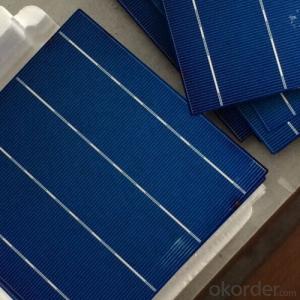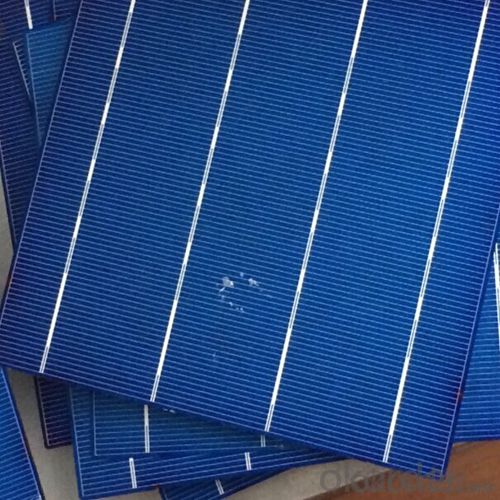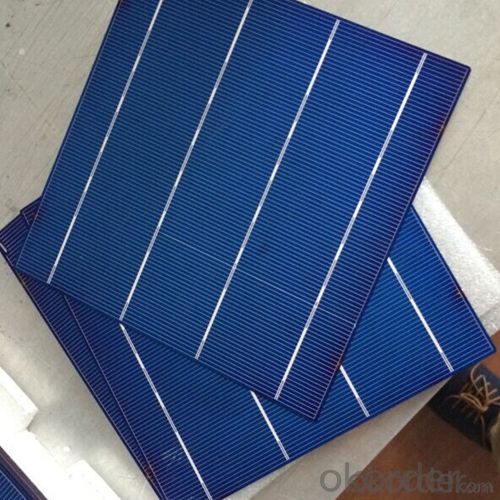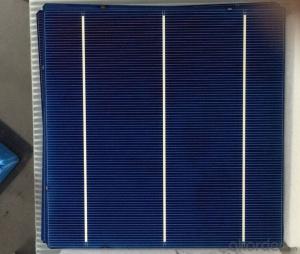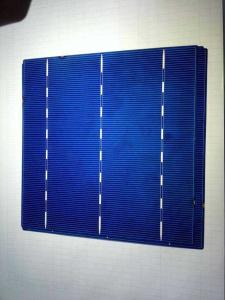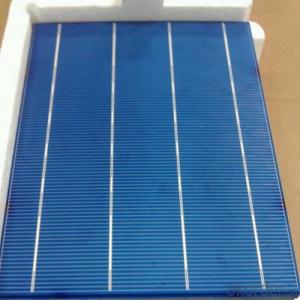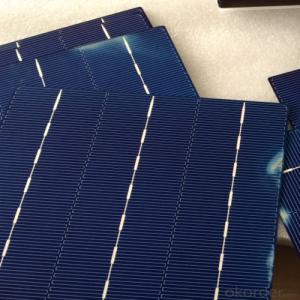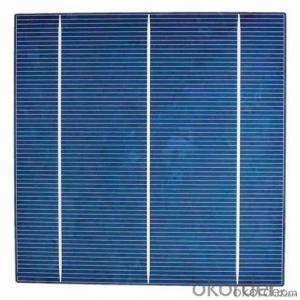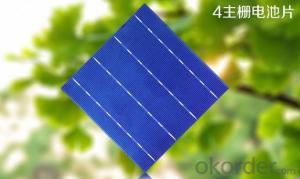III-V Solar Cells Poly Solar Cell 4BB Bus Bar B Grade with Low Price
- Loading Port:
- Shanghai
- Payment Terms:
- TT or LC
- Min Order Qty:
- 30000 pc
- Supply Capability:
- 3000000 pc/month
OKorder Service Pledge
OKorder Financial Service
You Might Also Like
Product description
Poly Solar Cell 4BB Bus Bar B Grade With Low Price
A solar cell, or photovoltaic cell, is an electrical device that converts the energy of light directly into electricity by the photovoltaic effect, which is a physical and chemical phenomenon.[1] It is a form of photoelectric cell, defined as a device whose electrical characteristics, such as current, voltage, or resistance, vary when exposed to light. Solar cells are the building blocks of photovoltaic modules, otherwise known as solar panels.
Solar cells are described as being photovoltaic irrespective of whether the source is sunlight or an artificial light. They are used as a photodetector (for example infrared detectors), detecting light or other electromagnetic radiation near the visible range, or measuring light intensity.
In contrast, a solar thermal collector supplies heat by absorbing sunlight, for the purpose of either direct heating or indirect electrical power generation from heat. A "photoelectrolytic cell" (photoelectrochemical cell), on the other hand, refers either to a type of photovoltaic cell (like that developed by Edmond Becquerel and modern dye-sensitized solar cells), or to a device that splits water directly into hydrogen and oxygen using only solar illumination.
Advantage Of Poly Solar Cell 156mm
1: High quality cell, Level B cell (14%—17.5%)
2.Dimensione:156*156mm Diagonal:200mm
3: Qualified certification: TUV,CE certification.
4: Warranty: five years for whole unit
Usage/Application Of Poly Solar Cell 4BB
1.The absorption of light, generating either electron-hole pairs or excitons.
2.The separation of charge carriers of opposite types.
3.The separate extraction of those carriers to an external circuit.
Product Images
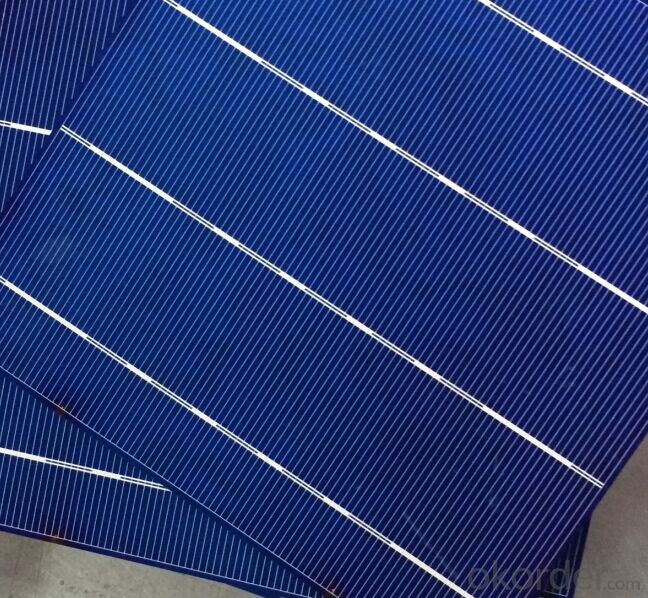
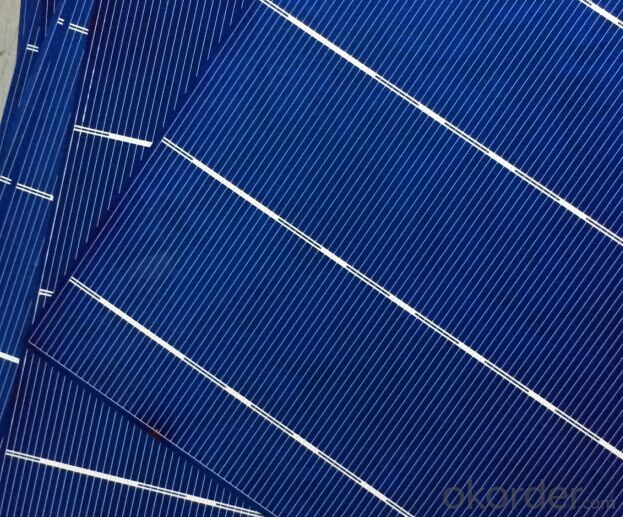
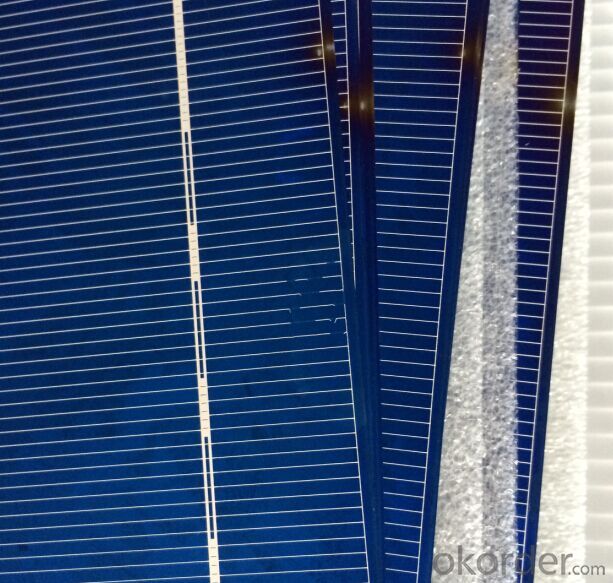
Temperature Coefficient of Cells
Voc. Temp . coef.%/K | -0.351%/K |
Isc . Temp . coef.%/K | +0.035%/K |
Pm. Temp. coef.%/K | -0.47%/K |
Electrical Characteristic
Efficiency (%) | Pmpp (W) | Umpp (V) | Impp (A) | Uoc (V) | Isc (A) | FF (%) |
17.25 | 4.197 | 0.524 | 7.992 | 0.62 | 8.458 | 80.03% |
17 | 4.137 | 0.524 | 7.876 | 0.619 | 8.353 | 80.01% |
16.75 | 4.076 | 0.522 | 7.81 | 0.617 | 8.286 | 79.73% |
16.5 | 4.015 | 0.518 | 7.746 | 0.613 | 8.215 | 79.73 |
16.25 | 3.955 | 0.515 | 7.683 | 0.61 | 8.144 | 79.61% |
16 | 3.894 | 0.512 | 7.613 | 0.608 | 8.075 | 79.31% |
15.75 | 3.833 | 0.51 | 7.534 | 0.605 | 8.058 | 78.62% |
15.5 | 3.772 | 0.508 | 7.453 | 0.604 | 8.02 | 77.87% |
15.25 | 3.771 | 0.505 | 7.35 | 0.604 | 9.997 | 76.83% |
15 | 3.65 | 0.503 | 7.271 | 0.604 | 7.989 | 75.64% |
14.5 | 3.529 | 0.499 | 7.067 | 0.604 | 7.988 | 73.14% |
14 | 3.407 | 0.499 | 6.833 | 0.604 | 7.833 | 72.01% |
Intensity Dependence
Intensity [W/m2] | Isc× [mA] | Voc× [mV] |
1000 | 1.00 | 1.000 |
900 | 0.90 | 0.989 |
500 | 0.50 | 0.963 |
300 | 0.30 | 0.939 |
200 | 0.20 | 0.920 |
FAQ
Q:What price for each watt?
A:It depends on the quantity, delivery date and payment terms
Q:What is your warranty system?
A:Our Solar cells performance guarantees for 25 years
Q:How do you pack your products?
A:We have rich experience on how to pack thecells to make sure the safety on shipment when it arrives at the destination.
- Q: How do solar cells handle voltage fluctuations in the grid?
- Solar cells do not directly handle voltage fluctuations in the grid. However, they can contribute to stabilizing the grid by generating electricity from sunlight, which helps balance the supply-demand equation. To manage voltage fluctuations, grid operators use various methods such as energy storage systems, inverters, and smart grid technologies that can regulate and control the flow of electricity in the grid.
- Q: How are solar cells used in spacecraft?
- Solar cells are used in spacecraft to convert sunlight into electricity, providing power to the various systems and instruments on board.
- Q: What is the difference between a monocrystalline and polycrystalline solar cell?
- Monocrystalline solar cells are made from a single crystal structure, resulting in a higher efficiency but also higher costs. On the other hand, polycrystalline solar cells are made from multiple crystal structures, making them less efficient but more cost-effective.
- Q: How do solar cells handle snow or ice buildup?
- Solar cells do not handle snow or ice buildup well. When covered by snow or ice, solar cells are unable to absorb sunlight effectively, leading to reduced energy production. To prevent this issue, solar panels are often installed at an angle, allowing snow and ice to slide off more easily. Additionally, some solar systems use heating elements to melt snow or ice that accumulates on the panels.
- Q: Are bulk solar cells better than the normal solar cells?
- It's hard to just simply say the bulk solar cells are better than normal solar cells. If the normal solar cells are better designed, it might be better than bulk solar cells.
- Q: Can solar cells be used for outdoor signage?
- Yes, solar cells can be used for outdoor signage. They are an environmentally friendly and sustainable option that can provide power to illuminate and operate outdoor signs. Solar cells can capture sunlight and convert it into electricity, making them an ideal choice for outdoor signage that is located in areas with ample sunshine.
- Q: Friends are fuel cells are chemical energy into electricity, solar cells are converted into electricity into electricity I would like to know in addition to the structure and the conversion of different ways there are no other differences hope that the specific power of everyone
- fuel for a wide range of: fuel cells can be applied to large urban power stations, but also as hospitals, shops, collective dormitories, remote mountainous areas of small power generation devices, as well as daily and national defense machinery used in walking power system. The development of fuel cells in the future new energy halo application of the major direction, its development has great social significance and economic significance.
- Q: Are solar cells weather-resistant?
- Yes, solar cells are weather-resistant. They are designed to withstand various weather conditions, including rain, snow, and extreme temperatures, without significant damage to their functionality.
- Q: Can solar cells be combined with energy storage systems?
- Yes, solar cells can be combined with energy storage systems. The integration of solar cells and energy storage systems allows for the capture and storage of excess energy generated by the solar cells during periods of high production. This stored energy can then be utilized during times when solar production is low or when there is a higher demand for electricity. This combination enables a more efficient and reliable renewable energy solution.
- Q: Can solar cells be used in powering e-bikes?
- Yes, solar cells can be used to power e-bikes. Solar panels can be installed on the e-bike to convert sunlight into electricity, which can then be used to charge the e-bike's battery. This allows for a sustainable and renewable source of energy to power the e-bike, reducing reliance on traditional electricity sources.
Send your message to us
III-V Solar Cells Poly Solar Cell 4BB Bus Bar B Grade with Low Price
- Loading Port:
- Shanghai
- Payment Terms:
- TT or LC
- Min Order Qty:
- 30000 pc
- Supply Capability:
- 3000000 pc/month
OKorder Service Pledge
OKorder Financial Service
Similar products
Hot products
Hot Searches
Related keywords
